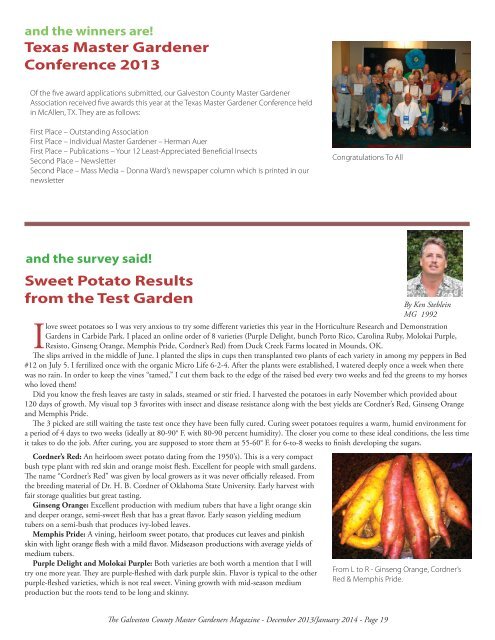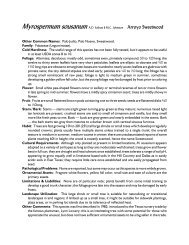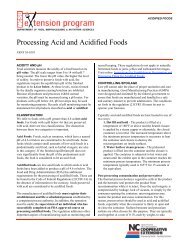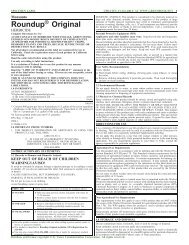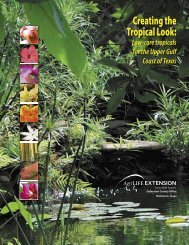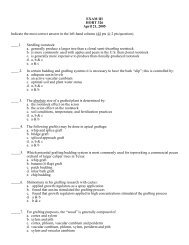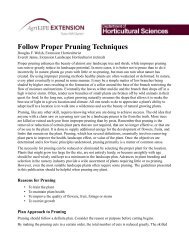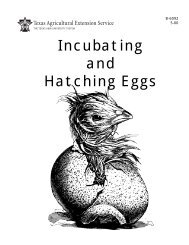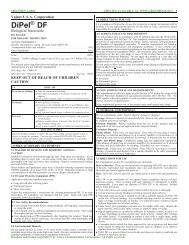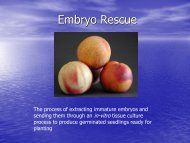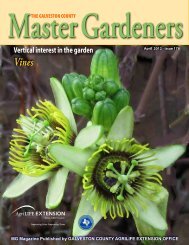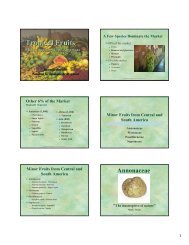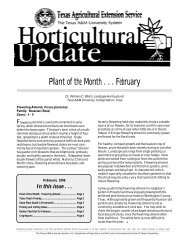Bulb Gardening - Aggie Horticulture - Texas A&M University
Bulb Gardening - Aggie Horticulture - Texas A&M University
Bulb Gardening - Aggie Horticulture - Texas A&M University
You also want an ePaper? Increase the reach of your titles
YUMPU automatically turns print PDFs into web optimized ePapers that Google loves.
and the winners are!<strong>Texas</strong> Master GardenerConference 2013Of the five award applications submitted, our Galveston County Master GardenerAssociation received five awards this year at the <strong>Texas</strong> Master Gardener Conference heldin McAllen, TX. They are as follows:First Place – Outstanding AssociationFirst Place – Individual Master Gardener – Herman AuerFirst Place – Publications – Your 12 Least-Appreciated Beneficial InsectsSecond Place – NewsletterSecond Place – Mass Media – Donna Ward’s newspaper column which is printed in ournewsletterCongratulations To Alland the survey said!Sweet Potato Resultsfrom the Test GardenBy Ken StebleinMG 1992Ilove sweet potatoes so I was very anxious to try some different varieties this year in the <strong>Horticulture</strong> Research and DemonstrationGardens in Carbide Park. I placed an online order of 8 varieties (Purple Delight, bunch Porto Rico, Carolina Ruby, Molokai Purple,Resisto, Ginseng Orange, Memphis Pride, Cordner’s Red) from Duck Creek Farms located in Mounds, OK.The slips arrived in the middle of June. I planted the slips in cups then transplanted two plants of each variety in among my peppers in Bed#12 on July 5. I fertilized once with the organic Micro Life 6-2-4. After the plants were established, I watered deeply once a week when therewas no rain. In order to keep the vines “tamed,” I cut them back to the edge of the raised bed every two weeks and fed the greens to my horseswho loved them!Did you know the fresh leaves are tasty in salads, steamed or stir fried. I harvested the potatoes in early November which provided about120 days of growth. My visual top 3 favorites with insect and disease resistance along with the best yields are Cordner’s Red, Ginseng Orangeand Memphis Pride.The 3 picked are still waiting the taste test once they have been fully cured. Curing sweet potatoes requires a warm, humid environment fora period of 4 days to two weeks (ideally at 80-90° F. with 80-90 percent humidity). The closer you come to these ideal conditions, the less timeit takes to do the job. After curing, you are supposed to store them at 55-60° F. for 6-to-8 weeks to finish developing the sugars.Cordner’s Red: An heirloom sweet potato dating from the 1950’s). This is a very compactbush type plant with red skin and orange moist flesh. Excellent for people with small gardens.The name “Cordner’s Red” was given by local growers as it was never officially released. Fromthe breeding material of Dr. H. B. Cordner of Oklahoma State <strong>University</strong>. Early harvest withfair storage qualities but great tasting.Ginseng Orange: Excellent production with medium tubers that have a light orange skinand deeper orange, semi-sweet flesh that has a great flavor. Early season yielding mediumtubers on a semi-bush that produces ivy-lobed leaves.Memphis Pride: A vining, heirloom sweet potato, that produces cut leaves and pinkishskin with light orange flesh with a mild flavor. Midseason productions with average yields ofmedium tubers.Purple Delight and Molokai Purple: Both varieties are both worth a mention that I willtry one more year. They are purple-fleshed with dark purple skin. Flavor is typical to the otherpurple-fleshed varieties, which is not real sweet. Vining growth with mid-season mediumproduction but the roots tend to be long and skinny.From L to R - Ginseng Orange, Cordner’sRed & Memphis Pride.The Galveston County Master Gardeners Magazine - December 2013/January 2014 - Page 19


